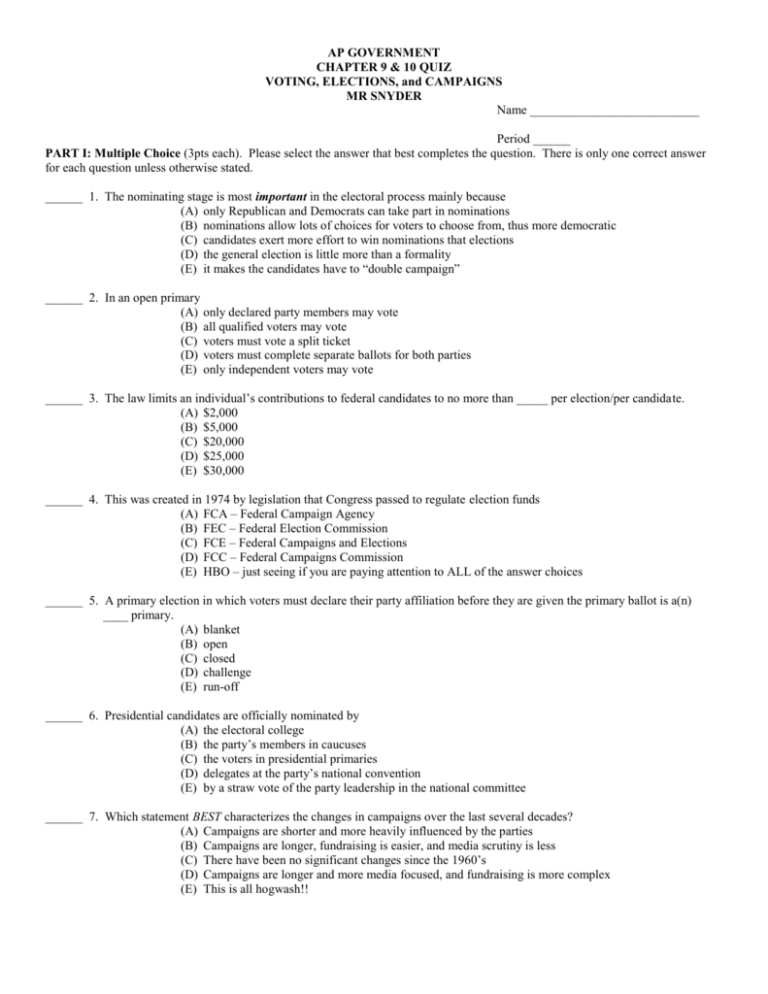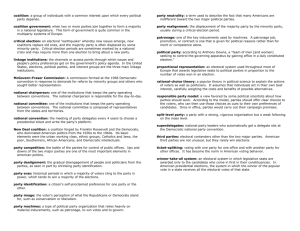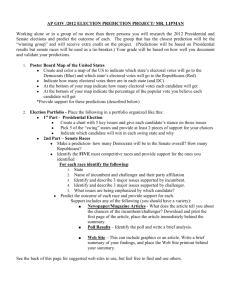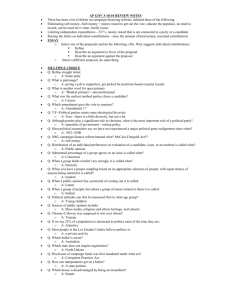AP GOVERNMENT CHAPTER 9 & 10 QUIZ VOTING, ELECTIONS
advertisement

AP GOVERNMENT CHAPTER 9 & 10 QUIZ VOTING, ELECTIONS, and CAMPAIGNS MR SNYDER Name ___________________________ Period ______ PART I: Multiple Choice (3pts each). Please select the answer that best completes the question. There is only one correct answer for each question unless otherwise stated. ______ 1. The nominating stage is most important in the electoral process mainly because (A) only Republican and Democrats can take part in nominations (B) nominations allow lots of choices for voters to choose from, thus more democratic (C) candidates exert more effort to win nominations that elections (D) the general election is little more than a formality (E) it makes the candidates have to “double campaign” ______ 2. In an open primary (A) only declared party members may vote (B) all qualified voters may vote (C) voters must vote a split ticket (D) voters must complete separate ballots for both parties (E) only independent voters may vote ______ 3. The law limits an individual’s contributions to federal candidates to no more than _____ per election/per candidate. (A) $2,000 (B) $5,000 (C) $20,000 (D) $25,000 (E) $30,000 ______ 4. This was created in 1974 by legislation that Congress passed to regulate election funds (A) FCA – Federal Campaign Agency (B) FEC – Federal Election Commission (C) FCE – Federal Campaigns and Elections (D) FCC – Federal Campaigns Commission (E) HBO – just seeing if you are paying attention to ALL of the answer choices ______ 5. A primary election in which voters must declare their party affiliation before they are given the primary ballot is a(n) ____ primary. (A) blanket (B) open (C) closed (D) challenge (E) run-off ______ 6. Presidential candidates are officially nominated by (A) the electoral college (B) the party’s members in caucuses (C) the voters in presidential primaries (D) delegates at the party’s national convention (E) by a straw vote of the party leadership in the national committee ______ 7. Which statement BEST characterizes the changes in campaigns over the last several decades? (A) Campaigns are shorter and more heavily influenced by the parties (B) Campaigns are longer, fundraising is easier, and media scrutiny is less (C) There have been no significant changes since the 1960’s (D) Campaigns are longer and more media focused, and fundraising is more complex (E) This is all hogwash!! ______ 8. Registered voters directly elect which of the following? I. The President and Vice President II. Supreme Court justices III. Members of the Senate IV. Members of the House of Representatives (A) (B) (C) (D) (E) I only IV only I and II only III and IV only II, III and IV only ______ 9. Which of the following reforms might potentially increase voter turnout in the United States? (A) making Election Day a public holiday (B) automatic registration (C) making it easier to cast absentee ballots (D) making voting mandatory (E) all of the above ______ 10. A state has a 11 electoral votes. In the presidential election, the Democratic candidate receives 48 percent of that state’s popular vote, the Republican candidate receives 40 percent of the vote, and an independent candidate receives 12 percent of the vote. If the state is similar to most other states, how will the electoral votes most likely be allocated? (A) The Democratic candidate will receive 5 electoral votes, the Republican will receive 4, and the independent will receive 2 (B) The Democratic candidate will receive 6 electoral votes and the Republican will receive 5 (C) The Democratic candidate will receive all 11 electoral votes (D) The votes will not be allocated until there has been a runoff election between the Democratic and Republican candidates (E) The House of Representatives will determine the allocation of the electoral votes ______ 11. To obtain the right to vote in the United States, one must (A) be a citizen (B) be 18 years old (C) be registered (D) a and b only (E) b and c only ______ 12. All of the following can be used to explain low voter turnout in America EXCEPT (A) voter apathy (B) lack of charismatic candidates (C) the nature of the political party system (D) significance of most elections perceived as low (E) the voter registration system ______ 13. Each state determines its number of electoral college votes by (A) each of its representatives in the U.S. House (B) every 10,000 registered voters (C) each of its citizens (D) each of ratios of Republican members to Democratic members (E) each of its representatives and senators ______ 14. If no presidential candidate receives a majority of the electoral college votes, or there is a tie, the election is decided by (A) the U.S. Congress (B) the House of Representatives (C) the Senate (D) votes in the fifty state legislatures (E) by who won the popular vote ______ 15. Many resources go into a successful campaign, but the most important resource appears to be (A) experience (B) a candidate’s knowledge of the issues (C) money (D) a candidate’s charisma (E) a candidate’s campaign manager ______ 16. So called soft money is (A) money collected from strong supporters with very little effort (B) promised contributions that are never delivered (C) money that does not fall under the normal spending limits because it is spent on behalf of the candidates (D) illegal and unreported campaign contributions (E) given directly to the candidate ______ 17. Most opposition to campaign finance reform was based on the idea that reform would(according to Buckely v. Valeo) (A) limit free speech (B) cause disorder (C) exacerbate social inequalities (D) result in all of the above conditions (E) none of the above ______ 18. The number of electoral votes needed to win the presidency (A) is 300 (B) changes from election to election (C) is 535 (D) is 370 (E) is 270 ______ 19. The greatest danger posed by the existence of the electoral college is that (A) a candidate might bribe electors to switch their votes (B) the allocation of electors to the states would not reflect the states’ populations (C) a candidate winning the popular vote might not receive a majority of electoral votes (D) irresponsible candidates could be elected because of their mass appeal (E) the electors in the college end up partying too much and fail out ______ 20. Federal law limits the amount an organization (PAC) may donate to a favorite candidate to (A) $1,000 per election (B) $5,000 per election (C) no limit (D) $3,000 per election (E) $10,000 per election ______ 21. The Federal Elections Commission is a regulatory agency whose purpose is to (A) enforce limits on campaign contributions and administer public funding of campaigns (B) ensure that no racial discrimination occurs in the voting process (C) do both a and b (D) do neither a or b (E) make waffles for the winning candidate ______ 22. The last major expansion of suffrage in the United States involved the criterion of (A) sex (B) wealth (C) race (D) property (E) age ______ 23. Residence requirements are used to (A) discourage people from moving just before elections (B) discourage election fraud (C) reduce the number of qualified voters (D) prevent non-citizens from voting (E) track people’s voting habits by state ______ 24. Nonvoting is a huge problem in the United States because (A) the vast majority of Americans never vote (B) most Americans do not believe in democracy (C) most voters think all elections are of equal importance (D) many Americans think voting does not make a difference (E) most Americans don’t have enough education to know how to vote ______ 25. To prevent fraudulent voting, most States require voters to (A) register (B) be able to read and write (C) pay a poll tax (D) be at least 18 years of age (E) none of the above ______ 26. Federal elections are held on (A) the 1st Monday after the 1st Tuesday in November of even-numbered years (B) the 1st Tuesday of November in even-numbered years (C) the 1st Tuesday after the 1st Monday in November of even-numbered years (D) the 2nd Tuesday after the 1st Monday in November of odd-numbered years (E) the 1st Tuesday and the 1st Monday in November of odd-numbered years ______ 27. Public monies are used to help finance which of the following campaigns? I. Presidential II. Congressional III. Gubernatorial (A) (B) (C) (D) (E) I only II only I and II only II and III only I, II and III ______ 28. Reported voter turnout _____ as age _____. (A) increases, increases (B) increases, decreases (C) stabilizes, increases (D) stabilizes, decreases (E) decreases, increases ______29. Most of the money that individual candidates spend during the course of a campaign is directed toward (A) media-related activities (B) campaign staff and advisors (C) travel-related expenses (D) campaign literature (E) the national convention ______30. PACs are (A) (B) (C) (D) (E) state commissions organized to reform campaign financing practices committees organized by interest groups to channel money to parties and candidates subcommittees of the FEC committees formed to lobby government officials on behalf of their interests groups organized by political activists to increase voter participation





